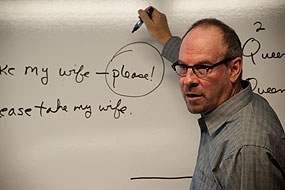“How to Write Short” by Roy Peter Clark
 You should write shorter. You should read Roy Peter Clark‘s book “How to Write Short: Word Craft for Fast Times” to learn how.
You should write shorter. You should read Roy Peter Clark‘s book “How to Write Short: Word Craft for Fast Times” to learn how.
The biggest problem with how people write now is that they are out of touch with how people read now. People read online, and the average article gets 20 seconds of attention.
But writing short is not so easy. It takes discipline. Poynter Institute senior scholar Roy Peter Clark wants to help you to develop that discipline. He is a student of everything from tweets to headlines to fortune cookies to song lyrics. In a series of short (of course) chapters, he opens your eyes to how short writers do what they do. As he says, “When it comes to the how of short writing, you will find three paths: learning short writing through reading; practicing the best short writing moves; and cutting longer texts down to size.” This is what he teaches; you should learn it.
Here are a few of my favorite quotes from the book, with the chapter they came from in bold, and my comments in brackets.

Follow the work of short writers. Think “picture postcard.” Look for a single image to imprint on the mind of readers and listeners. . . . Select the best piece of something spoken, not the whole speech. . . . Search and destroy redunandant elements. Adverbs are a favorite target, . . . as in totally severed or deeply rooted or curiously inquisitive. [A picture may be worth a thousand words, but a few words of imagery can do nearly as well.]
Write in the margins. To be a real reader, . . . you’ve got to mark up the page. . . . [W]riting in books [is] an indispensible tool of learning. [This changed my thinking about how to do research. What’s the digital equivalent of writing in the margin?]
No dumping. When I think of [the best online] writers . . . I am reminded that they share, in spite of their many differences, on essential writing value: . . . they never dump stuff online. I get the impression, . . . that they revise their writing online — no matter how short — with the same rigor they would bring to editing the chapters of a book. [Amen! Don’t dump your crap and make us sort through it.]
Cut it short. Remember Donald Murray’s aphorism “Brevity comes from selection and not compression.” [This is the best possible way to think about summarizing without turning your ideas into textureless mush.]
Entice [a chapter on dating profiles]. [W]ould a reader of my work discover in my writing voice someone worth talking to over a beer or a cup of coffee? Everything you write is, in essence, a dating profile. [Remember, in business writing, everything you create tells people who you are: somebody who gets to the point or a time-waster.]
List. Among reliable strategies [for making prose tighter]: sidebars, subheads, footnotes, paragraphing, and checklists. [If you think prose is what writing is about, you’ve ignored the ability to create structure with these types of tools. This chapter includes a list of 25 tips that is worth the price of the whole book.]
A few final words. The great writer, working in the short form, can look back on the history of writing for sources of inspiration and can build on the tradition of word craft — even in these fast times.
I feel that Roy Peter Clark is a fellow traveler. Get a copy of this book. It’s fun, and you’ll learn something.
I just cut three paragraphs from today’s blog post. This needs to become a habit for me.
I just ordered this book and see he’s got several others. Do you recommend any of them as highly?
How do you avoid writing nothing but bumper stickers and tweets?
Infomapping (www.informationmapping.com) is a powerful technique to achieve clarity with brevity.